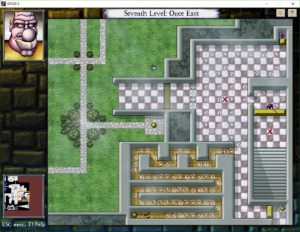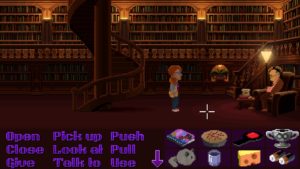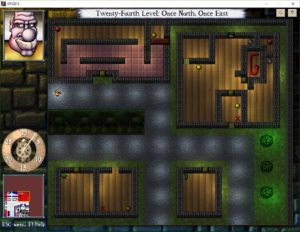In the waning days of 2016, a mystery emerged: Why did I just spend an entire day playing an anime-styled soft-porn match-3 game?
I guess the “why did I spend all day playing it” part isn’t much of a mystery: match-3 in the context of a larger overgame seems to just send me into a sort of trance. I experienced this with Puzzle Quest as well — although not with Candy Crush, which I think must be because CC is played entirely at the match-3 level.
No, the part that I have difficulty explaining even to myself is my motivation for buying the thing in the first place. It certainly wasn’t to ogle cartoon breasts. I mean, this is the age of the Internet; you don’t need a game for that. True, attaching it to a game could enhance the experience, making the nudie pics into a reward rather than merely an indulgence, but if that were my main concern, I wouldn’t be playing the weirdly censored Steam edition, which adds panties to pictures where they really don’t make sense. Rather, I think I was mainly moved by ludological curiosity. Puzzle Quest had been something of a revelation to me, showing how match-3 and RPG could not only coexist but cohere. What would happen if you tried the same thing with a dating sim in the place of the RPG?
Unfortunately, compelling as it is, I don’t think Hunie Pop lives up to the potential of its basic idea. This shouldn’t be surprising, considering how many closer Puzzle Quest imitators have failed to live up to the potential of theirs, even after Puzzle Quest showed them how to do it. On top of that, the mechanics have some weird implications for how romance works in the gameworld. Let’s go into detail.
The story sets up the player character as a lonely virgin until a “love fairy” named Kyu shows up to help you out by revealing the secrets of match-3 dating, the game’s central activity. In your initial explorations of the unnamed city, you meet eight women, and immediately start dating them all. (After a certain point, Kyu herself decides she wants in on the action and adds herself to your dating pool.) There’s a daily cycle of four time slots — morning, afternoon, evening, and night — and you can go on four dates with four different women every day if you want. No one ever says no to a date unless either you’ve already dated them that day, or they’re hungry, a condition easily cured. Dates are considered successful — meaning that the woman had a good time — if you reach a target score before your “remaining moves” counter runs out. There is no penalty for an unsuccessful date. After four successful dates with a woman, you can take her back to your apartment for sex, which is also a match-3 game. The sex version of match-3 is much simpler than the date version, but adds time pressure via a “pleasure meter” that decays towards zero if you don’t keep making matches.
Now, in real life, dating is a two-person activity. There exists a certain amount of precedent for representing two-person activities in match-3, like how Puzzle Quest uses it to represent combat, but they tend to be competitive and adversarial. Hunie Pop wisely avoids that: a dating game where the target of your efforts actively resists would be troubling, to say the least. But it doesn’t replace the competition with any sort of cooperative or collaborative activity. The player is the only active participant, performing the act of dating to a passive and judgmental audience who contributes nothing but the promise of sexual availability.
And not just passive, but interchangeable. Unless there’s something going on that was too subtle for me to notice, there isn’t any real difference between the women in the match-3 portion. The game attempts to establish some variety by giving them preferences for specific sorts of tiles, but since everyone simply has one tile type that scores more than usual and one type that scores less, it’s a distinction without a distinction. This is the game’s biggest failing as a game, if you ask me. Apart from the pictures, he only thing differentiating one date scenario from another is that the target score increases as you progress in the overall game. And that’s an across-the-board increase, unaffected by who you’re dating, or where, or when, or how much she likes you. Which, strangely, implies that dating is the one skill that becomes more difficult with practice.
That’s just in the match-3, mind. In the overgame, the dating sim around the match-3, the women do show some sign of differing personalities. Mechanically equivalent, sure, and also one-dimensional, capable of being summarized in a single sentence or even in some cases a single word, but at least distinct in ways that the game rewards you for paying attention to. By talking to women outside of dates, you can earn “hunie”, a word that, despite the designers’ intentions, I can’t help but mentally pronounce with a long U. Hunie is basically XP: you spend it on match-3 upgrades. Just talking to a woman at all earns you some hunie, but the big scores are found in the followup questions. Thus, conversation is essentially a guessing-game, and sometimes the women even openly acknowledge the fact, introducing their questions with “Quiz time!” or similar — once again, you perform, they judge. Sometimes you get to choose a question to ask, which the woman will quiz you about in a later conversation: “What’s your birthday?”, say, or “What’s your favorite place to hang out?”, or “What’s your cup size?” (All the women are oddly unfazed by the latter, even if it’s the very first thing you ask them.) Sometimes instead she’ll ask you a question, and these questions — “How close are you with your family?”, “How do you define happiness?”, “Is there anything about your past that you’re too ashamed to tell anyone?” — are a lot meatier than the ones you can ask them, both in terms of what they ask you and what the choice of question says about the asker. But it’s still just a matter of rewarding the one answer that pleases the woman the most, and moreover, it blatantly rewards lying. Some of the questions are asked by two different women who want contradictory answers. Some of them ask about sexual experiences that, at the beginning of the game, your character has not had. Now, you don’t have to lie in these situations. There’s no penalty for getting a question wrong. But the game is certainly encouraging the player here to play the role of a creep who’s willing to say anything to get into a girl’s pants.
Predictably, that’s not the end of the creep factor. At the beginning of the game, to facilitate finding specific women, Kyu gives you what amounts to a tracking device. Then of course there’s the fact that you’re dating nine people at once and, apart from Kyu, none of them know this. The initial introductions establish that some of the women are close friends with each other, and yet apparently they don’t talk about you at all. I’m thinking that this is part of the fantasy. Love is something that makes people anxious, makes them feel like they’re powerless and taking emotional risks. And so this game gives a fantasy of complete power and no consequences. Keeping each relationship separated from all other context is a way of maintaining control, much as abusers control their victims by isolating them.
Some of what I’ve described may be simply endemic to the conventions of the dating sim. As others have pointed out, the premise of the genre is “Any woman can be yours if you say the right words”. But Hunie Pop adds at least one significant element: a pervasive lack of negative consequences. Basically nothing you do in this game can hurt you in any way. There’s just one exception, which I think is worth describing: “broken heart” tiles. There will be a smattering of them in the grid for any date, and matching three of them is not merely bad for the date, but catastrophically bad and difficult to recover from. Managing your broken hearts is the most difficult and therefore the most interesting part of the match-3. There are powers you can use to get rid of the broken hearts, but timing when to use them is a tricky matter: you don’t want to waste them too early, but you also don’t want to put them off too long and wind up making a broken-heart match accidentally through a cascade. Which is really the only way they ever happen, accidental cascades. So in the one place where you can have real negative consequences, it’s not the direct result of a decision you made, but a matter of bad luck and/or poor risk management. Now, when you make matches in a date, the woman often makes approving comments along the lines of “Whoa, cool!”. When you match broken hearts, she’ll say something like “Would you cut that out?” in an exasperated tone, and the natural reaction is “I didn’t mean that to happen! It’s not my fault!”, which seems highly appropriate to the fiction.
The use of alcohol is worth mentioning. Given the fiction, buying drinks for women is almost unavoidable, but to what end? Surprisingly, the game manages to avoid the worst and most obvious choices here. Getting a woman liquored up does not make her easier to date or to get into bed. Instead, it applies a multiplier to any hunie you earn in that encounter. So the behavior the game rewards is: Get a woman as drunk as possible, then have a long conversation with her. (Ideally buying her a lot of food as well so you can talk with her longer.) Her inebriation may not help you now, but it’ll make you a better date in the long run. This doesn’t make a whole lot of sense, and I can only see it as a conscious rejection of the creepier alternatives — which suggests that any creepiness I find elsewhere in the game is inadvertent, or at least regarded as genre-normal by the devs.
 The overall theme of the seventh floor is puzzles involving invisibility potions and/or evil eyes — in particular, it makes puzzles out of the non-obvious fact that being invisible can be a liability, because monsters that can’t see you won’t chase you, and if they’re not chasing you, you can’t manipulate them into going where you want. The Slayer makes one appearance on this floor: after the repeated failure of his usual approach, he’s decided to just wait for you by the exit stairs. The stairs are near the floor’s start, but access to them is limited by an orb at the end of a long, winding hallway. If the Slayer follows you into that hallway, there’s no way to get back out. Thus, you need to be invisible, so he won’t follow you. There is an invisibility potion in the room, but you can only reach it if you enter via an alternate route in the south, which only opens after you conquer all of the other rooms in the level.
The overall theme of the seventh floor is puzzles involving invisibility potions and/or evil eyes — in particular, it makes puzzles out of the non-obvious fact that being invisible can be a liability, because monsters that can’t see you won’t chase you, and if they’re not chasing you, you can’t manipulate them into going where you want. The Slayer makes one appearance on this floor: after the repeated failure of his usual approach, he’s decided to just wait for you by the exit stairs. The stairs are near the floor’s start, but access to them is limited by an orb at the end of a long, winding hallway. If the Slayer follows you into that hallway, there’s no way to get back out. Thus, you need to be invisible, so he won’t follow you. There is an invisibility potion in the room, but you can only reach it if you enter via an alternate route in the south, which only opens after you conquer all of the other rooms in the level. Comments(1)
Comments(1)


